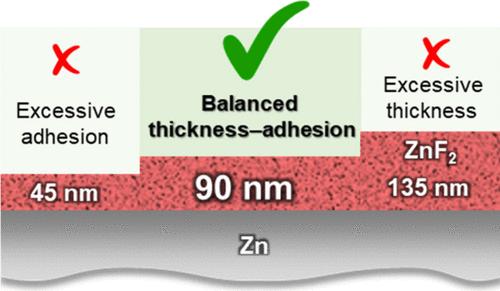超薄而有效:90纳米ZnF2层用于稳定锌金属阳极
IF 18.2
1区 材料科学
Q1 CHEMISTRY, PHYSICAL
引用次数: 0
摘要
水性锌离子电池的实际应用受到锌金属阳极枝晶形成和界面降解的限制。在这里,我们证明了超薄的ZnF2界面涂层,只有90nm厚,通过抑制副反应,促进均匀的锌沉积,并提供适度的机械附着力,显著提高阳极稳定性。znf2包覆Zn的对称电池在0.5 mA cm-2和3.0 mA cm-2下的寿命分别为1500 h和500 h。使用MnxV2O5阴极的电池在2000次循环后仍保持82%的容量。至关重要的是,纳米划伤测试表明,ZnF2薄膜的最佳厚度提供了合理的界面韧性,为人工保护层的机械-电化学协同设计提供了新的见解,这些因素迄今为止经常被忽视或研究不足。本研究推进了锌阳极的表面工程,并引入界面力学作为水电池系统中耐用人工保护层的设计参数。本文章由计算机程序翻译,如有差异,请以英文原文为准。

Ultrathin Yet Effective: 90 nm ZnF2 Layer for Stabilizing Zinc–Metal Anodes
The practical use of aqueous zinc-ion batteries is limited by dendrite formation and interfacial degradation at the Zn-metal anode. Here, we demonstrate that an ultrathin ZnF2 interfacial coating, merely 90 nm thick, significantly enhances anode stability by suppressing side reactions, promoting uniform Zn deposition, and providing moderate mechanical adhesion. Symmetric cells with ZnF2-coated Zn achieved lifespans of 1500 h at 0.5 mA cm–2 and 500 h at 3.0 mA cm–2. Full cells with MnxV2O5 cathodes retained 82% capacity after 2000 cycles. Crucially, nanoscratch tests revealed that the optimum thickness of ZnF2 films provided reasonable interfacial toughness, offering new insights into the mechanical–electrochemical codesign of artificial protective layers, factors that have often been overlooked or insufficiently investigated so far. This study advances surface engineering for Zn anodes and introduces interfacial mechanics as a design parameter for durable artificial protective layers in aqueous battery systems.
求助全文
通过发布文献求助,成功后即可免费获取论文全文。
去求助
来源期刊

ACS Energy Letters
Energy-Renewable Energy, Sustainability and the Environment
CiteScore
31.20
自引率
5.00%
发文量
469
审稿时长
1 months
期刊介绍:
ACS Energy Letters is a monthly journal that publishes papers reporting new scientific advances in energy research. The journal focuses on topics that are of interest to scientists working in the fundamental and applied sciences. Rapid publication is a central criterion for acceptance, and the journal is known for its quick publication times, with an average of 4-6 weeks from submission to web publication in As Soon As Publishable format.
ACS Energy Letters is ranked as the number one journal in the Web of Science Electrochemistry category. It also ranks within the top 10 journals for Physical Chemistry, Energy & Fuels, and Nanoscience & Nanotechnology.
The journal offers several types of articles, including Letters, Energy Express, Perspectives, Reviews, Editorials, Viewpoints and Energy Focus. Additionally, authors have the option to submit videos that summarize or support the information presented in a Perspective or Review article, which can be highlighted on the journal's website. ACS Energy Letters is abstracted and indexed in Chemical Abstracts Service/SciFinder, EBSCO-summon, PubMed, Web of Science, Scopus and Portico.
 求助内容:
求助内容: 应助结果提醒方式:
应助结果提醒方式:


